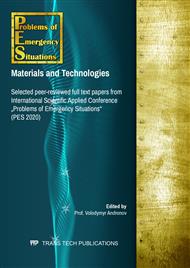p.79
p.87
p.93
p.101
p.107
p.117
p.123
p.130
p.136
Improvement of the Assessment Method for Fire Resistance of Steel Structures in the Temperature Regime of Fire under Realistic Conditions
Abstract:
There was researched the influence of fire temperature regimes, obtained by the proposed mathematical models, on the mechanical characteristics of metal structures. As a result, the identified patterns of the influence of the parameters of the premises with fires are shown as the slit coefficient decreases and the fire load density increases, the actual limit of fire resistance begins to decrease, as well as at values of fire load density less than 600 [MJ/m2], there is an area where the occurrence of a boundary state is not observed and Nomograms for determining the limit of fire resistance for steel structures at standard values of critical temperature were constructed and an appropriate method was developed.
Info:
Periodical:
Pages:
107-116
Citation:
Online since:
August 2020
Authors:
Price:
Сopyright:
© 2020 Trans Tech Publications Ltd. All Rights Reserved
Share:
Citation:


